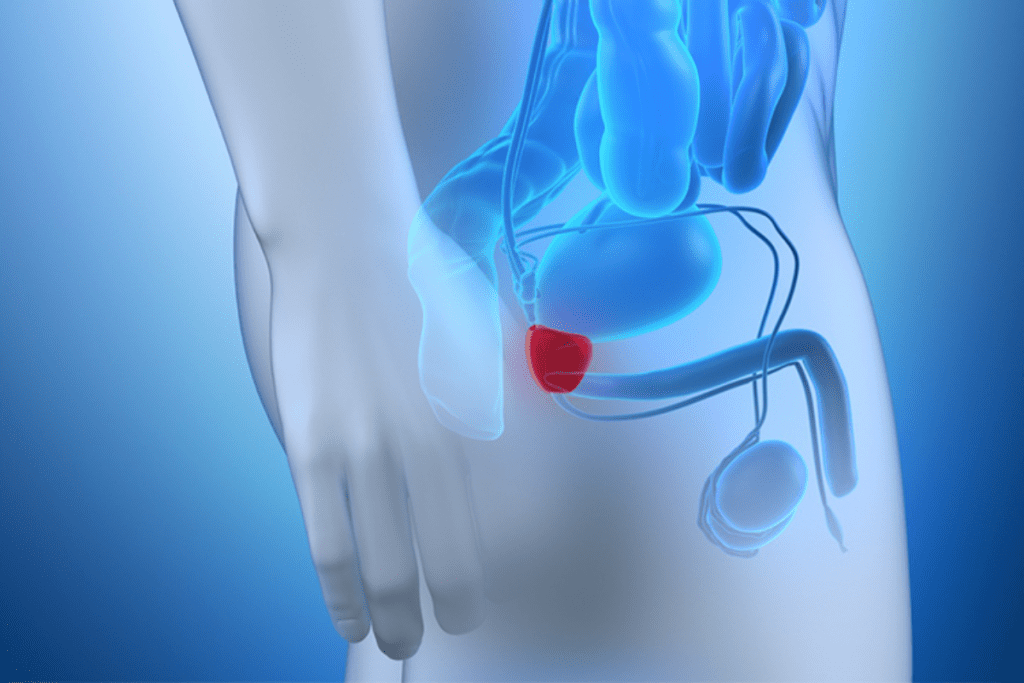Last Updated on October 31, 2025 by

Prostate health is a big worry for many men. Urologists are key in finding and treating prostate issues, including prostate cancer diagnosis. They give special care and advice.
Urologists are experts in treating the urinary and reproductive systems, including prostate problems. They help patients understand prostate health and guide them through prostate cancer diagnosis and treatment. They create treatment plans that fit each person.
Urologists use their knowledge to help patients with prostate issues. They offer advanced care and support. We count on their expertise for all prostate-related concerns, especially for early and accurate prostate cancer diagnosis.
Urologists are key in men’s health, tackling many urinary and reproductive issues. They have advanced training in urology. This makes them ready to diagnose and treat problems with the urinary tract and male reproductive system.

Urologists handle a variety of men’s health issues. This includes Benign Prostatic Hyperplasia (BPH) and erectile dysfunction. They also deal with prostate cancer. They do surgeries, give out medicines, and offer advice on keeping urinary and reproductive health good.
We count on urologists for full care. This includes regular check-ups, tests, and treatment plans made just for each person. They help with infertility, sexual dysfunction, and other issues that affect life quality.
To be a urologist, one must go through a lot of education and training. This includes getting a bachelor’s degree, then a medical degree, and finishing a urology residency. Some even do fellowships to get better at things like urologic oncology or male infertility.
Urologists keep up with new discoveries in their field. This means they can offer the best and newest treatments. Their deep knowledge lets them give care that fits each patient’s needs.
Urologists often deal with prostate issues like BPH, prostatitis, and nodules. These problems can really affect a man’s life, so getting the right diagnosis and treatment is important.
Benign Prostatic Hyperplasia (BPH) is when the prostate gets bigger but isn’t cancer. It’s common in older men and can cause trouble with urination. Doctors use exams, medical history, and tests like uroflowmetry to find out if someone has BPH.
How to treat BPH depends on how bad the symptoms are. Doctors might suggest changes in lifestyle, medicine, or even minor surgeries. Getting treatment early can really help improve your life.
Prostatitis is when the prostate gets inflamed, which can be sudden or long-lasting. It can cause pain, trouble peeing, and sex problems. Doctors split prostatitis into different types based on how long it lasts and what causes it.
Doctors treat prostatitis with antibiotics for infections, pain relief, and other help. It’s very important to get the right diagnosis for the best treatment.
Small nodules in the prostate can show up during a digital rectal exam or with tests like ultrasound or MRI. How serious these nodules are depends on many things, like the patient’s health, PSA levels, and what the nodule looks like.
Doctors might want to do more tests, like a biopsy, to see if the nodule is harmless or cancer. Spotting and diagnosing these issues early is vital for prostate health.

Urologists are key in finding prostate cancer. They use many methods to do this. We will explain how they diagnose prostate cancer, from the first tests to the latest techniques.
First, a digital rectal exam (DRE) and a prostate-specific antigen (PSA) test are done. A DRE lets the urologist feel the prostate for any oddities. The PSA test checks the blood for PSA levels. High levels might mean cancer, but could also show other issues like prostatitis or BPH.
If tests hint at cancer, we use more detailed methods. One is transrectal ultrasound (TRUS). It uses sound waves to see the prostate. This helps spot tumors and guide the biopsy needle.
A biopsy takes tissue samples for a microscope check. This is the best way to confirm cancer and how fast it’s growing.
It’s important to understand test results to know if cancer is present and how aggressive it is. The Gleason score shows how much the cancer cells look like normal cells. A higher score means the cancer is more aggressive.
Knowing the results of PSA tests, DRE, and biopsy helps us decide on treatment. We look at the patient’s health, age, and cancer stage to plan the best treatment.
Early detection is key for good treatment results. By knowing how to check for prostate cancer and understand test results, we can help patients better.
Prostate cancer statistics show a complex picture in America. They highlight how the disease affects different groups. Certain trends and disparities need more attention.
Projections show prostate cancer will keep being a big health issue in the U.S. By 2025, we’ll see more cases and deaths. Some groups will be hit harder than others.
Key statistics for 2025 projections include:
Racial disparities in prostate cancer outcomes are striking. African American men face higher rates of incidence and mortality. It’s key to understand these disparities to improve outcomes.
The reasons for these disparities are multifactorial. They include genetics, environment, and access to healthcare. By tackling these issues, we can narrow the gap in prostate cancer outcomes.
Finding prostate cancer early is key to managing it well. When caught early, treatment works better and survival chances improve.
Screening and early diagnosis are vital. They help treat cancer more effectively when it’s small. Regular check-ups and screenings are important for men, even more so for those with a family history or risk factors.
Key benefits of early detection include:
Men should know about risk factors like age, family history, and ethnicity. Knowing these can help men take better care of their health.
Survival rates for localized prostate cancer are nearly 100%. This shows how critical early detection is. But, if cancer is diagnosed later, survival rates drop sharply.
Survival rates by stage at diagnosis are as follows:
These numbers stress the need for early detection and action. We urge men to talk to their doctors about their risk and screening options.
There are many ways to treat prostate conditions. These include medication, minimally invasive procedures, and surgery. Each option is chosen based on the condition, its severity, and the patient’s health and wishes.
Medication is often the first choice for treating prostate issues. For example, alpha-blockers and 5-alpha-reductase inhibitors help with Benign Prostatic Hyperplasia (BPH). They relax the muscles in the prostate and bladder neck, making it easier to pee.
For some conditions, less invasive methods work well. Transurethral Microwave Therapy (TUMT) and Transurethral Needle Ablation (TUNA) use heat to shrink the prostate. This helps reduce symptoms.
Surgery is needed in some cases. Transurethral Resection of the Prostate (TURP) is a common surgery for BPH. It removes prostate tissue that blocks urine flow.
For prostate cancer, radical prostatectomy is an option. This surgery removes the prostate gland. The choice to have surgery depends on the cancer’s stage, the patient’s health, and other factors.
Not every prostate condition needs immediate treatment. Active surveillance is recommended for men with low-risk prostate cancer. It involves watching the cancer closely with regular PSA tests, exams, and biopsies. Treatment is delayed until the cancer shows signs of growing.
This approach helps avoid the side effects of aggressive treatments. It keeps quality of life high while treating the cancer if it gets worse.
Urologists are key in taking care of prostate health. They handle everything from finding problems to helping with treatment and ongoing support. They make sure patients get the best care from start to finish.
Urologists are very important for men’s health, mainly when it comes to prostate cancer. They help people understand their options and make choices that are right for them. This way, patients get the care they need.
Handling prostate cancer is a big job, and urologists are at the forefront. They guide patients through the tough times. With their knowledge, they offer care that’s tailored to each person’s needs.
A urologist is a doctor who deals with the urinary tract and male reproductive system. They treat issues like BPH, prostatitis, and prostate cancer.
First, a digital rectal exam and a PSA test are done. Then, more tests like transrectal ultrasound (TRUS) and biopsy might be needed.
Diagnosing prostate cancer involves a digital rectal exam, PSA test, and imaging studies. A biopsy is done if needed. It’s important to understand these tests.
Treatment for prostate cancer depends on the cancer’s type and the patient’s health. Options include medication, surgery, or active surveillance for low-risk cases.
Urologists are key in men’s health, focusing on prostate issues. They help choose the best treatment and offer support.
Early detection of prostate cancer involves regular screening. This includes a digital rectal exam and PSA test. It helps catch the disease when it’s most treatable.
Small nodules in the prostate can be found during a digital rectal exam or imaging studies. Their importance depends on the patient’s health and PSA levels.
Diagnosing prostate conditions requires various tests. These include digital rectal exams, PSA tests, imaging studies, and biopsy. They help find and understand the condition.
Urologists treat common prostate issues like BPH, prostatitis, and prostate cancer. They offer personalized care and help choose the right treatment.
Subscribe to our e-newsletter to stay informed about the latest innovations in the world of health and exclusive offers!